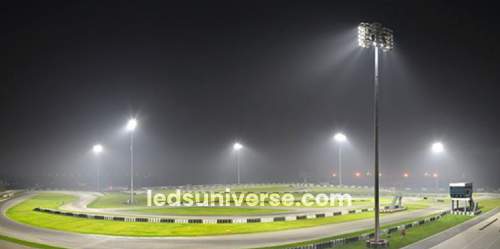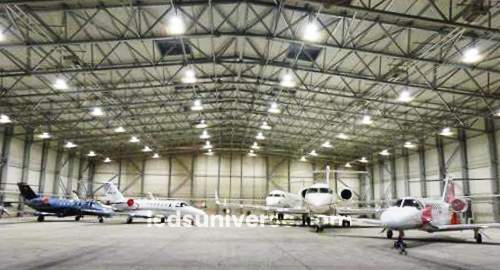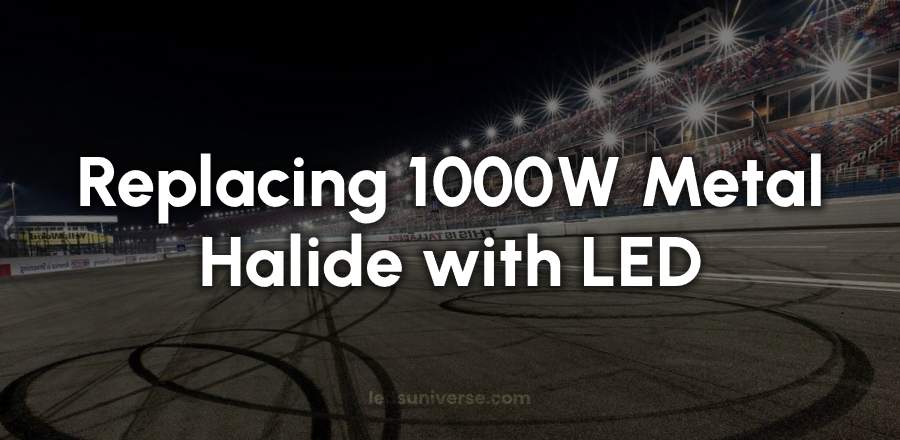Table of Contents
ToggleThe Rise of LED Technology in Modern Lighting
Over the past few decades, lighting technology has undergone a transformative shift, with LED lighting emerging as a dominant solution. Once reliant on metal halide and high-pressure sodium (HPS) systems, various industries have steadily embraced LED lighting due to its energy-efficient nature, offering long-term cost savings and enhanced performance. LED lighting systems are now known for producing light that is 2 to 2.5 times brighter than traditional metal halide and HPS lamps while reducing energy consumption by 60 to 70%.
Traditional Metal Halide Usage and the Shift to LED
 Historically, metal halide lamps were widely used in large-scale applications, such as sports fields, airports, industrial facilities, seaports, and mining operations. These high-intensity discharge (HID) lamps provided the brightness necessary for such vast spaces. However, with the increasing demand for more energy-efficient and eco-friendly options, the shift towards LED lighting began around 2008. The continual advancements in LED technology have introduced better solutions for lighting, enabling many industries to improve both their energy consumption and light quality.
Historically, metal halide lamps were widely used in large-scale applications, such as sports fields, airports, industrial facilities, seaports, and mining operations. These high-intensity discharge (HID) lamps provided the brightness necessary for such vast spaces. However, with the increasing demand for more energy-efficient and eco-friendly options, the shift towards LED lighting began around 2008. The continual advancements in LED technology have introduced better solutions for lighting, enabling many industries to improve both their energy consumption and light quality.
LED Replacement for 1000-Watt Metal Halide: Power Equivalency
 The key consideration when replacing a 1000-watt metal halide with an LED light is not the wattage but the amount of light output. The efficiency of LED lighting lies in the fact that its brightness is measured in lumens, which is the quantity of visible light emitted by a source. Metal halides, by comparison, generate significant energy loss in the form of heat, reducing their efficiency.
The key consideration when replacing a 1000-watt metal halide with an LED light is not the wattage but the amount of light output. The efficiency of LED lighting lies in the fact that its brightness is measured in lumens, which is the quantity of visible light emitted by a source. Metal halides, by comparison, generate significant energy loss in the form of heat, reducing their efficiency.
For instance, a 1000-watt metal halide lamp can be effectively replaced by a 400 to 500-watt LED light. This equivalency is based on lumen output rather than energy consumption. LEDs can deliver the same or even greater levels of brightness with much less power. As a result, the transition to LED lighting offers substantial energy savings while maintaining the desired light levels.
Understanding Lux and Lumen in Lighting Design
When comparing LED lights with traditional metal halide lamps, the concept of lux becomes an essential factor. Lux refers to the amount of light that reaches a surface at a specific distance. It is a direct measurement of light intensity on the ground or at waist height. Lumen, on the other hand, represents the total light output produced by a light source.
LED lighting produces lumens more efficiently than metal halide systems, with light that is better directed and more effectively distributed. This means that fewer watts are needed to achieve the same brightness and coverage. While metal halides disperse light in all directions, LEDs provide a focused beam, maximizing their lux output and reducing the amount of light wasted through reflection or diffusion.
Efficiency and Brightness of LED Systems
 The enhanced efficiency of LED lighting stems from its ability to convert energy into visible light rather than heat. Traditional lighting technologies such as metal halides suffer from high energy loss due to heat emission. In contrast, LED lights operate at lower temperatures and deliver more focused illumination, making them ideal for replacing metal halide fixtures.
The enhanced efficiency of LED lighting stems from its ability to convert energy into visible light rather than heat. Traditional lighting technologies such as metal halides suffer from high energy loss due to heat emission. In contrast, LED lights operate at lower temperatures and deliver more focused illumination, making them ideal for replacing metal halide fixtures.
For example, to replace a 1000-watt metal halide, an LED light with a power consumption of 400 to 500 watts is typically sufficient. This LED replacement provides comparable brightness while significantly lowering energy consumption. Furthermore, the efficiency of LED lighting is also reflected in its longer lifespan, requiring fewer replacements over time and further reducing maintenance costs.
Lumens and Lumen Depreciation in Metal Halide and LED Lighting
One of the major drawbacks of metal halide lighting is its rapid lumen depreciation. Over time, metal halide lamps lose a substantial amount of their brightness while still consuming the same amount of energy. After three to four years, these lamps may operate at only half their original light output. Despite this loss of efficiency, the energy consumption remains unchanged, leading to higher operational costs.
In contrast, LED lighting is designed to maintain a high level of brightness throughout its lifespan. Many LED systems come with an L70 rating, which ensures that the light output will remain at least 70% of its original level even after a decade of use. This slower rate of lumen depreciation makes LED lights a more reliable and cost-effective solution for long-term lighting needs.
The Reflection Issue in Metal Halide Lighting
Metal halide lamps emit light in all directions, often resulting in significant light loss due to reflection. Reflectors are typically used to focus the light emitted by metal halides, but these systems are inefficient, with up to 30% of light being lost in the process. LED lights, by contrast, emit light directionally, meaning they are more effective at targeting specific areas without relying on reflectors. This directional quality allows LED systems to maximize their light output while minimizing wasted lumens.
Retrofitting vs. Full Fixture Replacement for LED Conversion
When considering the replacement of metal halide fixtures with LED systems, there are two primary options: retrofitting or full fixture replacement. Retrofitting involves replacing only the bulb within the existing fixture, allowing for a straightforward and cost-effective upgrade. However, some believe that retrofitting may not deliver the same level of performance as replacing the entire fixture. This is not always the case, as many modern LED systems are designed to work efficiently within existing frames, delivering enhanced light output and efficiency even with retrofit kits.
For those seeking the most comprehensive upgrade, a full fixture replacement may be the best option. This involves replacing both the fixture and the light source, providing the opportunity to optimize the lighting design for LED technology. Whether retrofitting or replacing the fixture, LED lighting ensures improved light quality, energy savings, and reduced maintenance costs.
LED Replacement Options and Equivalencies for Metal Halide Lights
The transition from metal halide to LED lighting can be made across a range of applications, with equivalencies available for different wattage levels. For example:
| LED Floodlight Power | Equivalent Metal Halide Power |
|---|---|
| 100-watt LED | 250-watt Metal Halide |
| 200-watt LED | 500-watt Metal Halide |
| 300-watt LED | 750-watt Metal Halide |
| 400-watt LED | 1000-watt Metal Halide |
| 600-watt LED | 1500-watt Metal Halide |
| 800-watt LED | 2000-watt Metal Halide |
These equivalencies highlight the superior efficiency of LED systems, which can deliver the same brightness with significantly less energy consumption.
Benefits of LED Lighting Over Metal Halides in Long-Term Use
Beyond the immediate energy savings and improved light quality, LED lighting offers several long-term benefits. One of the most significant advantages is its extended lifespan. LED lights can last up to 100,000 hours or more, far outlasting the 10,000 to 20,000-hour lifespan of metal halide lamps. This durability reduces the need for frequent replacements, further lowering maintenance costs.
Another key benefit of LED lighting is its environmental impact. By consuming less energy and producing fewer greenhouse gas emissions, LED systems contribute to a reduction in overall energy consumption and carbon footprints. This makes them an attractive option for businesses and industries looking to enhance their sustainability initiatives.
Conclusion
The transition from metal halide to LED lighting represents a significant step forward in lighting technology. With improved energy efficiency, longer lifespan, and superior light output, LED systems offer numerous advantages over traditional metal halide lamps. By embracing LED technology, businesses and industries can enjoy brighter, more reliable lighting while reducing their environmental impact and operational costs. Whether retrofitting existing fixtures or opting for a complete upgrade, LED lighting provides a modern solution for today’s lighting needs.
